

E36 Convertible Adjust. BMW E36 Lighting For Noobs - Part 1 of 4. DIY Oxygen Sensor Replacement. Oxygen sensors are a critical part of the BMW emissions control system Introduction Replacement of oxygen sensors is very simple in principle -- so simple, in fact, that I'd normally not consider it worth a DIY article -- but when was all said and done I felt I'd learned enough about the parts and the process to communicate something of value.
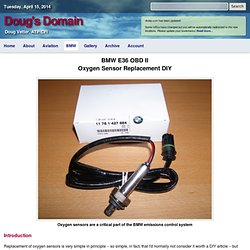
This article explains what I needed to know to replace my oxygen sensors. Emissions Background The BMW E36 comes in two flavors -- 1995 and prior cars equipped with OBD I, and 1996 and later vehicles equipped with OBD II. My 1998 E36 328is came from the factory with the tubular stainless steel headers and twin-pipe midsection from the M3. BMW recommends replacement of oxygen sensors every 100K miles and they have a very good reason for this. Replacement of the pre-cat sensors alone can reach $700 or more if performed at the dealer, which explains why I chose to do this job myself. Prerequisites. BMW Valve Cover Gasket DIY. Doug Vetter, ATP/CFI dvatp.com has been updated!

Some URLs have changed but you will be automatically redirected to the new locations. Please update your bookmarks! Read more... BMW engines are not known for oil leaks, but all engines eventually need some TLC, like replacement of the valve cover gasket. Introduction When you think about old cars that leak oil in the driveway, BMWs don't usually come to mind, but as the engines age various rubber sealing gaskets dry out and lose their ability to keep oil where it should be.
BMW E36 HK Speaker Upgrade DIY. Doug Vetter, ATP/CFI dvatp.com has been updated!
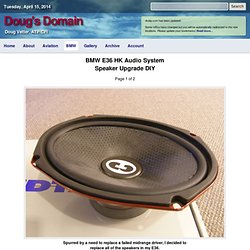
Some URLs have changed but you will be automatically redirected to the new locations. Please update your bookmarks! Read more... BMW E36 Fuel Filter DIY. Doug Vetter, ATP/CFI dvatp.com has been updated!
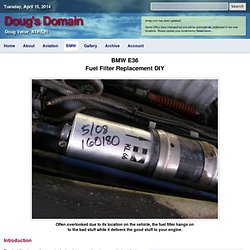
Some URLs have changed but you will be automatically redirected to the new locations. Please update your bookmarks! Read more... Often overlooked due to its location on the vehicle, the fuel filter hangs on to the bad stuff while it delivers the good stuff to your engine. Introduction The fuel filter is an often overlooked maintenance item because it's installed on the underside of the vehicle behind a protective cover. The recommended replacement interval for the fuel filter on an E36 is every Inspection II, or every 36K miles.
Prerequisites. BMW E36 Power Window Motor and Regulator DIY. Doug Vetter, ATP/CFI dvatp.com has been updated!
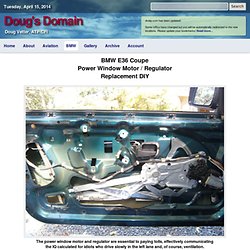
Some URLs have changed but you will be automatically redirected to the new locations. Please update your bookmarks! Read more... The power window motor and regulator are essential to paying tolls, effectively communicating the IQ calculated for idiots who drive slowly in the left lane and, of course, ventilation. BMW E36 Idle Control Valve and Crankcase Vent DIY. Doug Vetter, ATP/CFI dvatp.com has been updated!

Some URLs have changed but you will be automatically redirected to the new locations. Please update your bookmarks! Read more... Failure modes for the idle control valve and crankcase vent aren't pretty. Introduction This DIY outlines the labor required to replace three functionally separate parts, the idle control valve (ICV), crankcase vent (CCV), and intake manifold air temperature sensor, which are defined as follows: Idle Control Valve (ICV) - This is essentially a low-flow, high precision throttle body that provides fine grained control of the engine below approximately 20% throttle. The procedure required to gain access to these parts is quite similar, hence they are combined into this single DIY. Troubleshooting The ICV can become clogged with carbon deposits and fail to open and close smoothly. BMW electrical diagrams. E36 electrical diagram. Pelican Technical Article: BMW Valve Cover Replacement. One of the more common oil leaks on BMW engines is the large, long valve cover gasket.
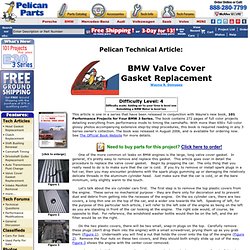
In general, it's pretty easy to remove and replace this gasket. This article goes over in detail the procedure to replace the valve cover gasket. Begin by prepping the car. The only thing that you really need to do is to make sure that the car is cold. If you try to remove or install spark plugs in a hot car, then you may encounter problems with the spark plugs gumming up or damaging the relatively delicate threads in the aluminum cylinder head. Let's talk about the six cylinder cars first. On the two plastic covers, there will be two small, snap-in plugs on the top. BMW E36 328i FRONT SEAT PAN/PAD. Diagram Selection. [FAQ]: A guide on E36 lighting, HIDs, and projector retrofits. - DTMPower BMW Forum. When I first wrote this thread, it was in response to many questions I received about projector retrofits (because at the time I was in the process of finishing my TSX retrofit), but it has evolved into a semi-comprehensive guide on HID lighting in the E36.
![[FAQ]: A guide on E36 lighting, HIDs, and projector retrofits. - DTMPower BMW Forum](http://cdn.pearltrees.com/s/pic/th/lighting-projector-retrofits-22323823)
I've tried to stick with basic, objective, info about HIDs ("xenons"). I learned this stuff (and still learn about it) by reading and reading and reading about it on various websites and forums (like HIDplanet). This thread assumes some very basic knowledge about HID systems. If you'd like to know more about the basics of HIDs, I suggest you check out Wikipedia's section on HIDs. Anyway, assuming you've read that or that you know what HIDs are, let's move onto the specific lighting setups available for the E36: Stock E36 lighting in the US: Stock US plastic headlights have 9006 reflectors in both the low and high beam.
European reflectors: Many of the stock E36 lights in continental Europe (UK excluded) are Bosch H7 halogen reflectors. Shark Injector Install Instructions.